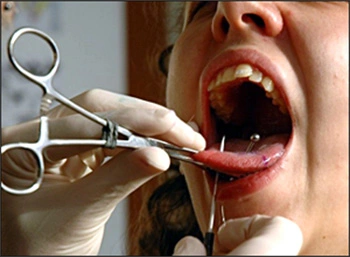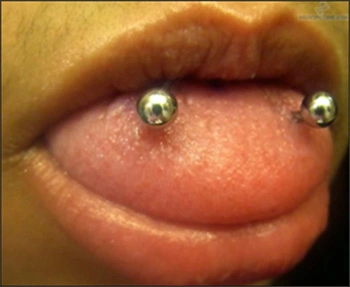Oral Piercings: Implications for Dental Professionals
Course Number: 688
Definition of Oral Piercing
Oral piercing is defined as the cosmetic piercing of the oral cavity for the insertion of objects such as rings, studs or pins where both ends of the jewelry are confined to the oral cavity.2,13,21 A needle is inserted to create an opening through which a decorative ornament may be worn (Figure 1).9
Figure 1. Tongue being pierced with needle.
The term oral piercing may include perioral piercings. Perioral piercings are piercings where one end of the jewelry is intraoral and the other end penetrates the skin surface of the cheeks, upper/lower lip or the chin.2 The broader term of facial piercings includes piercings of the nose and eyebrows. The placement of a piercing may contribute to the name of the piercing.25 An additional oral modification includes tongue splitting where the tongue is divided into 2 lateral halves, creating a ‘forked’ appearance.2,3,20 The tongue is the most common oral piercing site, followed by lips (including the labiomental groove and the philtrum), cheeks, lingual or maxillary labial frenum or some combination. Rarely, the uvula may be pierced.25 The uvula is seldom pierced as it is difficult to perform the piercing as well as place the jewelry. There are concerns with aspiration or swallowing of the jewelry both during the piercing process and subsequent wearing of the jewelry. Issues such as the gag reflex, throat irritation, risk of nausea and interference with swallowing also contribute to the rarity of uvula piercing (Figure 2).11,19
Figure 2. Uvula piercing.
There are two types of tongue piercings: the dorsoventral and the dorsolateral.21 The dorsoventral tongue piercing is the most common and safer as it generally avoids most major blood vessels. The tongue is pierced in the midline just anterior to the lingual frenum and the jewelry is generally worn so there is a sphere on both the dorsal and ventral surfaces of the tongue (Figure 3).
Figure 3. Pierced tongue with jewelry in place.
The dorsolateral tongue piercing is not a safe procedure due to the tongue’s vascularity and is generally not performed by professional piercers. In this piercing, the 2 spheres of the jewelry are both on the dorsum of the tongue, close to the lateral borders and about half way anteroposteriorly. The curved barbell between the spheres curves ventrally and resurfaces dorsally. This piercing is sometimes called the venom bite as it resembles a snake bite (Figure 4).26
Figure 4. Dorsolateral tongue piercing.
The labret is on the lower lip just above the labiomental crease (Figure 5).
Figure 5. Labret piercing.
A piercing on the upper lip, off center and resembling a beauty mark for which these women are known, includes the Madonna, on the right side, and the Monroe, on the left side (Figure 6).
Figure 6. Madonna and Monroe piercings.
A Medusa piercing is in the philtrum of the upper lip, centered and just below the nose (Figure 7).
Figure 7. Medusa piercing.
A Jestrum (vertical Medusa, vertical labret or vertical philtrum) is an upper lip piercing placed in the philtrum and exits from the center of the upper lip, allowing both sides of the jewelry to be visible (Figure 8).
Figure 8. Jestrum piercing.
Source: RightPiercing.com.
A Smiley piercing pierces the maxillary labial frenum (Figure 9), a Frowny pierces the mandibular labial frenum (Figure 10) and a Web pierces the mandibular lingual frenum (Figure 11).
Figure 9. Smiley piercing.
Figure 10. Frowny piercing.
Figure 11. Web piercing.
A Rhino piercing goes through the tip of the nose, and the result resembles a rhino horn (Figure 12).
Figure 12. Rhino piercing.
A gingival or trans-gum piercing is the least common oral piercing. It is placed between teeth numbers 8 & 9, penetrating both the gingiva and bone (Figure 13).26
Figure 13. Gingival or trans-gum piercing.
Source: Body Modification Ezine.
Another unusual tooth modification is referred to as a tooth piercing, however the jewelry is attached to the tooth surface; no hole is drilled in the tooth. The usual site of this modification is the incisal third of maxillary anterior teeth and ring type jewelry is commonly used (Figure 14).
Figure 14. Tooth piercing.
Source: Body Piercing Magazine.















